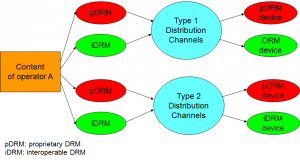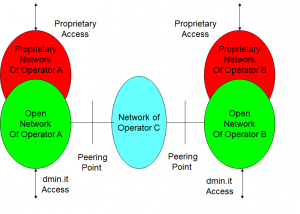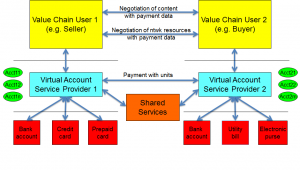| Previous chapter | Next section | Next chapter | |
| ToC | Digital Media For Machines | The First Application Formats | Frameworks For Digital Media |
At the end of May 2005, I was invited to make a speech at an internal school of Mediaset (the main private broadcaster in Italy) in Cologno Monzese, near Milan. On that occasion I met Juan Carlos De Martin of the Polytechnic of Turin and Massimo Travostino, an attorney specialising in Intellectual Property. On our way back we discussed the idea of “doing something for Italy” in the space of Digital Media.
It took five months of preparation, but on the 5th of November we were able to open a workshop with a large participation from various sectors of the Italian industry and society. Workshop participants agreed on the name Digital Media in Italia, the acronym (including domain name) dmin.it and the mission
an interdisciplinary, open, non-profit group with the purpose to define action areas that enable Italy to play a primary role in the exploitation of the global “digital media” phenomenon.
By “digital media” dmin.it means any digitally-represented content that can be carried by digital networks and processed by digital devices, particularly if these are programmable.
This was for me an opportunity to put into practice a number of ideas that I had hatched in the last 20 years and that I have illustrated in the previous pages:
- Digital media has the potential to disrupt existing media businesses: just look at the MP3 and DivX phenomena
- Compression is the enabling factor of everything that relates to digital media: just look at the way TV channel multiplication changes the nature of broadcasting
- Content management and protection is the key enabling technology for content distribution and monetisation: depending on whether management and protection technologies are open of closed radically different business models can be deployed
Italy was a very interesting case study for implementing my ideas: a midsize country, with a content industry of a significant size, but not enough to make it a sustainable global player. Left to market forces Italy ran the risk that it would become a “land of conquest” of the big international Content and Service Providers because the content distribution business models of the analogue world would simply be reproduced in the digital domain. Indeed already at that time it was already clear that the many innovation attempts made since introduction of digital technologies had failed and what remained were digital value chains that looked very much like old analogue value chains. Even new and promising open distribution methods such as Creative Commons licences have a hard time to show their innovation potential.
On the other hand, if the possibilities offered by digital technologies that I have illustrated in the previous pages were exploited with an open mind, Italy could hope to play a role by creating a homogeneous market underpinned by some technologies that the group would specify. The slogan adopted was
The goal of dmin.it is to maximise the flow of digital media.
The first workshop was followed by a series of meetings that led to the approval of the Draft dmin.it Proposal in September 2006. Then it took another 15 months before the Complete dmin.it Proposal could be given the final shape.
The dmin.it proposal provides the necessary technological, normative and governance tools to realise the objective that dmin.it had set to itself. More specifically the proposal identified, specified, and defined the conditions for an effective use of three key technologies:
- Format for distribution of digital media (iDRM).
- Access to broadband digital networks (iNet).
- Pay and cash based on points (iPay).
dmin.it dodnot propose a standardisation of technologies that excluded the use of other technologies by the force of law. Indeed an action of this kind, even though its benefits were historically assessed, did not correspond to the trend. dmin.it simply proposed that, next to technologies selected by value chain operators to satisfy their needs, the interoperable dmin.it technologies be used to satisfy end user needs.
Concerning the format, dmin.it observed that Digital Rights Management (DRM) technologies, both for the purpose of management and protection, were used pervasively in the market for controlling distribution of digital media and that there were international treaties, obligations coming from the European Union and national laws that regulated rights and duties stemming from the use of DRM. Therefore dmin.it assessed that any proposal aiming at substantially altering such a legislative context would be unrealistic.
On the other hand it was widely recognised that use of proprietary DRM technologies entailed significant impediments to:
- Contents providers (authors, composers, interprets and producers) who needed millions of consumption devices deployed – an extremely expensive undertaking – in order to be able to distribute their works.
- Consumers who had to stand significant costs in order to be equipped of all devices that were required to access all contents of their interest and find it difficult to move content between different devices.
- Service providers who typically found it difficult to hook up to value chains.
- Italian companies who found it difficult to operate in the national market fragmented and dominated by multinational behemoths.
Therefore dmin.it proposed that the law determine that operators who release content with proprietary DRM technologies must release the same content also using the “interoperabile DRM” (iDRM) technologies specified by dmin.it, at conditions that are not discriminatory if compared with those used by the operator to release content with proprietary DRM technologies.
Concerning access to broadband digital networks, dmin.it proposed that the law determine that a broadband digital network operator can offer access to his network based on freely determined technical characteristics, provided a network user (content provider, intermediary or end user) may request and obtain from that broadband digital network operator the raw “service-agnostic” access to “big Internet”, according to dmin.it specification, with the technical features adopted by the operator his offer and at conditions not discriminatory if compared with those used by the operator for his own offer.
Concerning pay and cash, dmin.it proposes that anybody, within the terms of banking regulation, may offer “account” services that are not directly monetary (points, credits) for transactions connected to the use of digital media, as specified by dmin.it. Transactions could be effected between “accounts” that relied on payment instruments with guaranteed cashing, e.g. bank account, credit card, prepaid card, electronic purse etc. Synchronisation of an “account” with its payment only effected at fixed times or on demand.
dmin.it believed that making it possible for
- Authors/performers/interpreters/producers to release their content with the assurance that there is broad installed basis of consumption devices capable of interpreting the content
- Consumers to access and use a large content base
- Intermediaries to hook up easily to content value chains
was a potent factor enabling the attainment of dmin.it objectives.
Therefore dmin.it, instead of proposing an exclusive standardisation of format, access and pay/cash technologies, proposed to place next to the tools that operators freely decide to adopt for their needs those proposed by dimin.it. The value added brought by dmin.it tools lied in the fact that users were assured that an interoperable mode existed.
The dmin.it proposal identified an equilibrium point between the demand of operators to retain the freedom to select those technologies that best match the needs of their business and the demand of interoperability coming from the two end points of the value chains – authors, performers, interpreters and producers on one end and consumers on the other hand – and from intermediaries who decided to base their business on ’interoperability”.
dmin.it believed that its proposal could create a potential homogeneous market of 60 million people capable of stimulating both the national cultural industry and innovation in the market of digital media thus helping the national cultural and technology industry to achieve a leading position in the global market.
Format technologies (iDRM)
For format technologies, dmin.it proposed that an interoperable Digital Rights Management (iDRM) specification be adopted at the national level.
dmin.it adopted the NIST definition of DRM as “A system of Information Technology components and services that strive to distribute and control content and related rights with digital technologies”. The “i” prefixed to DRM meant that dmin.it OLNY supported the interoperable, i.e. standard, version of DRM. dmin.it DID NOT support (but was not and might not be against) the use of non-interoperable DRM if parallel to iDRM.
Therefore ,dmin.it proposed that the law determine that service providers who released content using a proprietary DRM technology should ALSO release the same content using the iDRM technology at not discriminatory conditions if compared with those employed to release content using the proprietary DRM technology. This is depicted in Figure 1.
Figure 1 – Distribution of content with proprietary and interoperable DRMs
The iDRM specification is based on the DMP Interoperable DRM Platform (IDP).
Anybody may (but is not obliged to) implement (hardware and software) devices and services, request and obtain, if the implementation qualifies, a conformity certificate and offer them to third parties with an “iDRM” mark so that no conflicts are created.
The iDRM specification was made public, and implemented in Open Source Software with a Mozilla Public Licence (MPL 1.1) licence. It did not prescribe specific business models, in line with the part above related to the meaning of “Management” in the iDRM acronym.
The iDRM specification was not comparable with the specifications of the “black box” and monolithic DRM solutions found in the market, because iDRM is a toolkit specification. This approach allowed users to implement value chains corresponding to a large number of business models with improved levels of interoperability, using the same basic tools configured to suit their needs.
Access technologies (iNet)
dmin.it proposed that for access to digital broadband networks:
- Digital broadband network operators may offer bundled and/or unbundled access to their networks with technical characteristic of their choice.
- A network user (content provider, intermediary or end user) could request and obtain from a digital broadband network operators the raw “service-agnostic” access to the “big Internet” according to the iNet specification within the technical characteristics already part of the operator’s offer at non discriminatory conditions if compared with the other offers by the operator.
- Digital broadband network operators guarantee network service interoperability by agreeing on and providing specific levels of quality of service (QoS) at peering points so as to provide network users appropriate levels of QoS.
Figure 2 depicts the dmin.it proposal for access to digital broadband networks.
Figure 2 – Open access to digital broadband network
Pay/cash technologies (iPay)
dmin.it proposed for pay/cash of content that:
- Anybody, within the terms of banking regulation, could offer not directly monetary (points, credits) “account” services for transactions connected to the use of digital media, according to the iPay specification;
- Transactions are effected between “accounts” that rely on payment instruments with guaranteed cashing, e.g. bank account, credit card, prepaid card, electronic purse etc.;
- Synchronisation of an “account” with its payment means was effected at fixed times or on demand.
Figure 3 depicts the proposal.
Figure 3 – System to record and convert points for digital media
dmin.it proposed its payment protocols to MPEG and they became part of MPEG-M Part 4 for “Transactions”.
Additionally, dmin.it explored changes required to the Italian legislation to accommodate the dmin.it proposals and found that only small changes to the copyright & telecom legislation were needed for iDrm and iNet, while a Virtual Account Service Provider (VASP) could be a Payment Institution of the EU Payment Service Directive.
dmin.it also identified the tasks of a body governing the dmin.it ecosystem:
- To manage the system in the interest of all parties
- To manage the certification process
- To manage the specification life cycle
- To resolve disputes between parties
- To ensure financial sustainability
| Previous chapter | Next section | Next chapter | |
| ToC | Digital Media For Machines | The First Application Formats | Frameworks For Digital Media |


